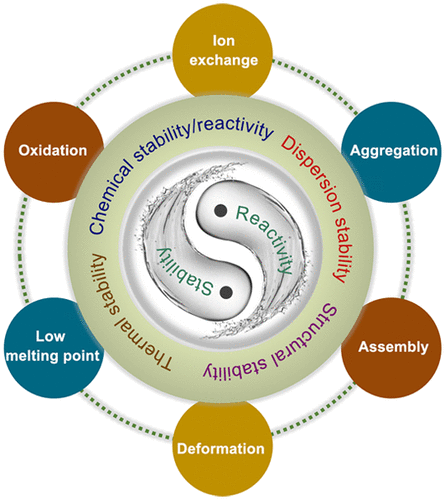当前位置:
X-MOL 学术
›
Chem. Rev.
›
论文详情
Our official English website, www.x-mol.net, welcomes your
feedback! (Note: you will need to create a separate account there.)
Stability and Reactivity: Positive and Negative Aspects for Nanoparticle Processing
Chemical Reviews ( IF 51.4 ) Pub Date : 2018-03-08 00:00:00 , DOI: 10.1021/acs.chemrev.7b00208 Liang Xu 1 , Hai-Wei Liang 1 , Yuan Yang 1 , Shu-Hong Yu 1
Chemical Reviews ( IF 51.4 ) Pub Date : 2018-03-08 00:00:00 , DOI: 10.1021/acs.chemrev.7b00208 Liang Xu 1 , Hai-Wei Liang 1 , Yuan Yang 1 , Shu-Hong Yu 1
Affiliation

|
Nanoparticles exist far from the equilibrium state due to their high surface energy. Nanoparticles are therefore extremely unstable and easily change themselves or react with active substances to reach a relatively stable state in some cases. This causes desired changes or undesired changes to nanoparticles and thus makes them exhibit a high reactivity and a poor stability. Such dual nature (poor stability and high reactivity) of nanoparticles may result in both negative and positive effects for nanoparticle processing. However, the existing studies mainly focus on the high reactivity of nanoparticles, whereas their poor stability has been neglected or considered inconsequential. In fact, in some cases the unstable process, which is derived from the poor stability of nanoparticles, offers an opportunity to design and fabricate unique nanomaterials, such as by chemically transforming the “captured” intermediate nanostructures during a changing process, assembling destabilized nanoparticles into larger ordered assemblies, or shrinking/processing pristine materials into the desired size or shape via selective etching. In this review, we aim to present the stability and reactivity of nanoparticles on three levels: the foundation, concrete manifestations, and applications. We start with a brief introduction of dangling bonds and the surface chemistry of nanoparticles. Then, concrete manifestations of the poor stability and high reactivity of nanoparticles are presented from four perspectives: dispersion stability, thermal stability, structural stability, and chemical stability/reactivity. Next, we discuss some issues regarding the stability and reactivity of nanomaterials during applications. Finally, conclusions and perspectives on this field are presented.
中文翻译:

稳定性和反应性:纳米颗粒加工的积极和消极方面
纳米粒子由于其高表面能而远离平衡状态。因此,在某些情况下,纳米粒子极不稳定并且容易改变自身或与活性物质反应以达到相对稳定的状态。这导致纳米颗粒发生期望的变化或不期望的变化,因此使它们表现出高反应性和差的稳定性。纳米颗粒的这种双重性质(差的稳定性和高反应性)可能导致纳米颗粒加工的负面影响和正面影响。然而,现有的研究主要集中在纳米颗粒的高反应性上,而其不良的稳定性却被忽略或认为是无关紧要的。实际上,在某些情况下,由于纳米颗粒的稳定性差而导致的不稳定过程为设计和制造独特的纳米材料提供了机会,例如,通过在更改过程中化学转化“捕获的”中间纳米结构,将不稳定的纳米颗粒组装成更大的有序组件,或通过选择性蚀刻将原始材料收缩/加工成所需的尺寸或形状。在这篇综述中,我们旨在从三个层次上介绍纳米颗粒的稳定性和反应性:基础,具体表现形式和应用。我们首先简要介绍一下悬空键和纳米粒子的表面化学。然后,从四个方面介绍了纳米颗粒稳定性和高反应性的具体表现:分散稳定性,热稳定性,结构稳定性和化学稳定性/反应性。接下来,我们讨论有关纳米材料在应用过程中的稳定性和反应性的一些问题。
更新日期:2018-03-08
中文翻译:

稳定性和反应性:纳米颗粒加工的积极和消极方面
纳米粒子由于其高表面能而远离平衡状态。因此,在某些情况下,纳米粒子极不稳定并且容易改变自身或与活性物质反应以达到相对稳定的状态。这导致纳米颗粒发生期望的变化或不期望的变化,因此使它们表现出高反应性和差的稳定性。纳米颗粒的这种双重性质(差的稳定性和高反应性)可能导致纳米颗粒加工的负面影响和正面影响。然而,现有的研究主要集中在纳米颗粒的高反应性上,而其不良的稳定性却被忽略或认为是无关紧要的。实际上,在某些情况下,由于纳米颗粒的稳定性差而导致的不稳定过程为设计和制造独特的纳米材料提供了机会,例如,通过在更改过程中化学转化“捕获的”中间纳米结构,将不稳定的纳米颗粒组装成更大的有序组件,或通过选择性蚀刻将原始材料收缩/加工成所需的尺寸或形状。在这篇综述中,我们旨在从三个层次上介绍纳米颗粒的稳定性和反应性:基础,具体表现形式和应用。我们首先简要介绍一下悬空键和纳米粒子的表面化学。然后,从四个方面介绍了纳米颗粒稳定性和高反应性的具体表现:分散稳定性,热稳定性,结构稳定性和化学稳定性/反应性。接下来,我们讨论有关纳米材料在应用过程中的稳定性和反应性的一些问题。











































 京公网安备 11010802027423号
京公网安备 11010802027423号